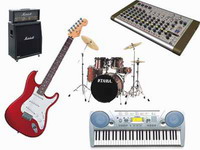Login form
Musical Instruments
 Everybody likes to pick up something and make noise with it. Haven’t you banged your spoon on the table? Or run your finger around the top of a glass of water to make it hum? You probably didn’t think of this as playing a musical instrument. But it’s likely that musical instruments got started this way—perhaps by people beating two sticks together, blowing on hollow stalks, or rattling dried pods with seeds in them.
Everybody likes to pick up something and make noise with it. Haven’t you banged your spoon on the table? Or run your finger around the top of a glass of water to make it hum? You probably didn’t think of this as playing a musical instrument. But it’s likely that musical instruments got started this way—perhaps by people beating two sticks together, blowing on hollow stalks, or rattling dried pods with seeds in them.
WHAT’S IN A SOUND?
Anything that makes sound could be a musical instrument. But we usually think of musical instruments as objects specially created to produce the sounds of the music we know—folk, rock, classical, and all other types.
Musical instruments range from simple to complex. They differ from one part of the world to another. But all instruments produce sound the same way, by means of vibrations (rapid back-and-forth movements). These vibrations reach our ears as sound waves. We can group musical instruments into families by how they produce vibrations. Vibrations come from striking, plucking, and blowing on instruments, or by moving a bow across them. Faster vibrations produce higher notes.
INSTRUMENTS WE STRIKE
Instruments we strike range from hollowed-out logs to complicated bells. We strike gongs and xylophones. When we shake a rattle, objects inside it strike the rattle’s wall and make a sound. Our fingers can strike or scrape against a washboard or the rim of a glass to produce sounds. Instruments that make sounds by striking them have been used since the Stone Age. Striking the instrument starts the vibrations.
Sometimes we strike an object that has a skin or other membrane stretched tight across it. This kind of instrument is a drum. The stretched membrane vibrates to produce the sound. Drums are found in nearly every culture around the world.
INSTRUMENTS WE BLOW ON
Flutes, trumpets, saxophones, and other instruments produce sound through vibrations of air. A flute sounds when we breathe air into a hole on its side or its end. By covering finger holes on the flute, we can change the pitch of the notes—how high or low the notes are.
In some instruments, a thin piece of metal or plastic in the mouthpiece vibrates when we blow on it. These instruments are called reed instruments. They include the bassoon, clarinet, oboe, and saxophone. The bagpipe is also a reed instrument. The bagpiper blows air into the bags, and presses the bags to send air into the pipes where a reed vibrates. Pressure from our lips helps make the air vibrate when we blow into a horn, trombone, trumpet, or tuba.
INSTRUMENTS WITH STRINGS
Some musical instruments, such as violins and harps, have strings that vibrate. Stretching the strings by plucking or striking makes them vibrate. Violins, violas, and cellos are played by drawing a bow across their strings. The guitar, lute, banjo, and harp have strings that are plucked with the fingers. The piano has strings and a keyboard. Pressing a key on the keyboard causes a string to be hit with a small hammer.
INSTRUMENTS WITH ELECTRICITY
Some instruments use electrical equipment to produce or change their sounds. Electric guitars use electric current to make their sound a lot louder than the usual guitar. Synthesizers use electric current to produce sound. A group of synthesizers linked together can produce the sound of an entire orchestra. Computers control sound synthesizers made today.
Source: Microsoft ® Encarta

